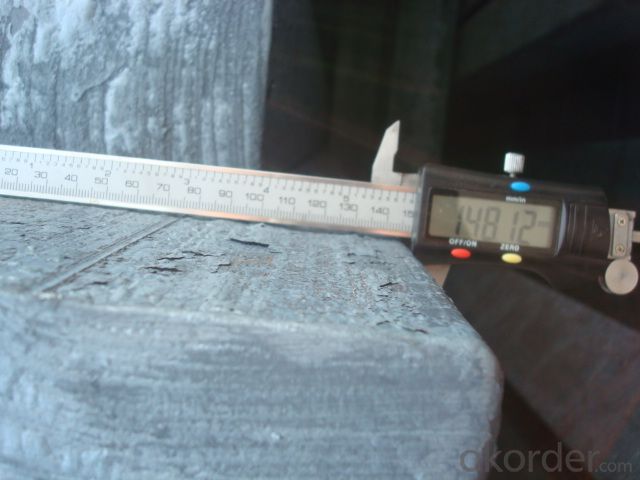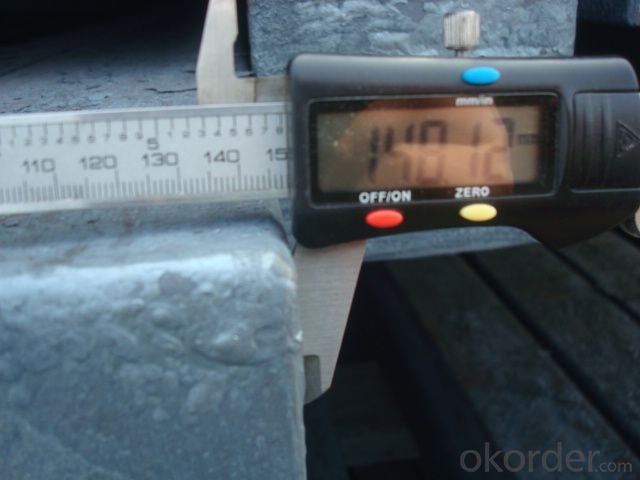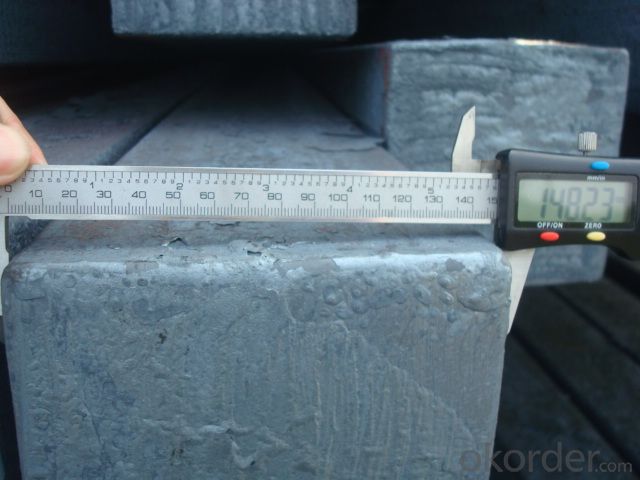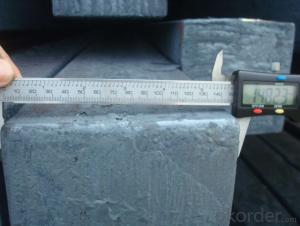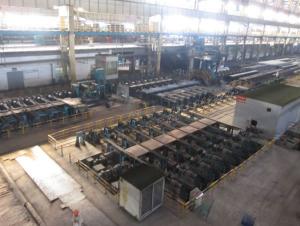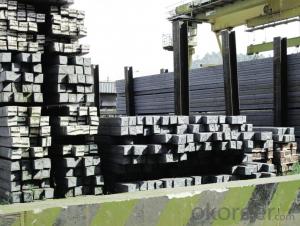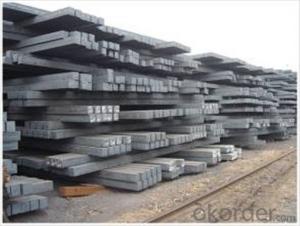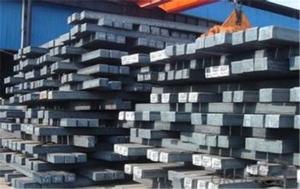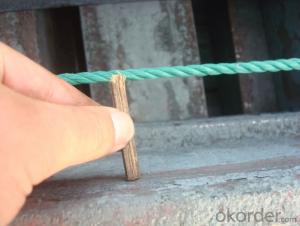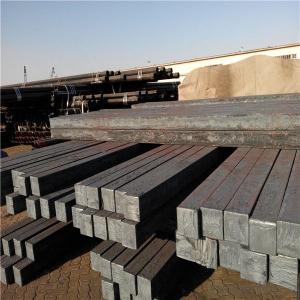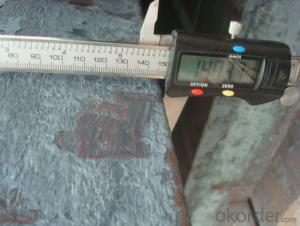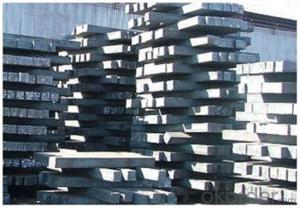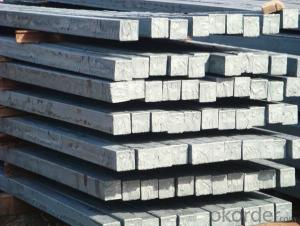Hot Sale Q275/5SP Square Steel Billets 50mm-180mm
- Loading Port:
- Tianjin
- Payment Terms:
- TT OR LC
- Min Order Qty:
- 1000 m.t.
- Supply Capability:
- 30000 m.t./month
OKorder Service Pledge
OKorder Financial Service
You Might Also Like
STEEL BILLET
1.Brief description
Steel billet(ingot) by cogging or breakdown of semi-finished products, is the raw material of all kinds of steel mill. Billet section of square, round, flat, rectangular and abnormity of several kinds of, mainly related to the shape of rolled products.
2.Features
Rectangular billet continuous casting billet and mainly general carbon steel, low carbon low silicon cold-rolled material, high quality carbon structural steel, high strength low alloy steel, special steel, etc.
The billet is mainly divided into two kinds from the shape:
Slab: cross section width and height of the ratio of the larger, mainly used for rolling plate.
Billet: equal cross section width and height, or a huge difference, mainly used for rolling steel, wire rod. ,
Steel billets have distinct characteristics as compared with already furnished steel bars and products. Billets have a specific grain structure, which enables the metal to be processed more intricately. Steel billets are also known for their malleability and ductility, especially when exposed to varying temperatures during shaping and molding.
3.Processing
Steel billets are considered fresh and raw, and they must undergo a series of manufacturing processes before they can be used for various purposes. Billets are made by means of freezing molten liquid, and are later exposed to extremely low temperatures in order to allow the metal to take shape and solidify in chemical structure. The temperature manipulates the metal's physical properties, and tones its strength and durability. The subsequent processes provide the metal's curved mold design so that it can fit the allotted space provided by other machines, which complete the finishing procedures.
4.Pictures

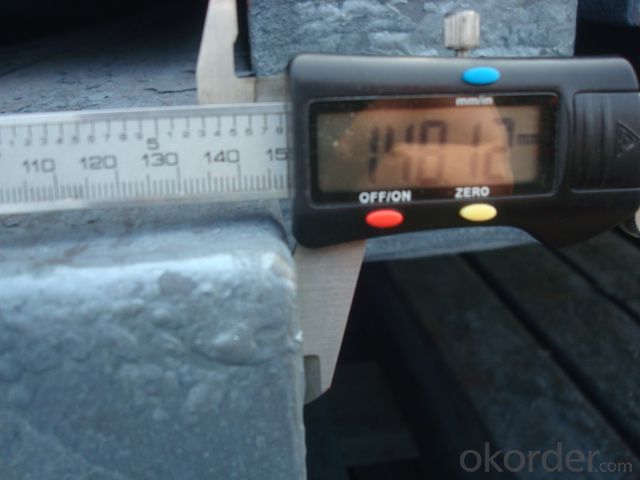
5.Usage
Billets, or ingots (as they sometimes referred to), are not of practical use until they have been formed into more functional shapes and sizes. While they have already been put in the furnace, they still require a series of shaping and molding procedures such as hot and cold working, milling and cutting before they are sold in hardware stores, or used for different applications. The unformed billets, however, can be used in striking currency such as coins and as reserves, similar to gold bars.
6.Detailed specification
Hot rolled billet steel
Size: 50x50mm-180x180mm
Steel Grade: 3SP, 5SP,Q195,Q235,Q255,Q275 Length:3m-12m
MOQ: 1000MT/size
Payment term: TT or LC
Packing: in bulk , bundle
Shipment: by container , bulk vessel
Packaging Details: bundles with steel strips or as customers's requirements
Delivery time: 15-30 days after the deposit
Loading port:Tianjin, or other port China
Origin : China
Inspection:Third party inspection before loading.
- Q: How are steel billets used in the production of agricultural components?
- Steel billets are an essential raw material used in the production of various agricultural components. These billets serve as the starting point for the manufacturing process, where they are transformed into a wide range of agricultural components such as plows, harrows, tillers, cultivators, and seeders. The steel billets are first melted down and cast into a solid form, typically a rectangular or square shape, with a consistent cross-section. This solid piece of steel is then heated and rolled into the desired shape and size required for the specific agricultural component being produced. Once the billets have been rolled and shaped, they undergo further processes such as cutting, drilling, bending, and welding to form the final agricultural component. These components are designed to withstand the demanding conditions of the agricultural industry, including exposure to harsh weather, heavy loads, and frequent use. Steel billets offer several advantages in the production of agricultural components. Firstly, steel is a strong and durable material, providing the necessary strength and resilience required for agricultural machinery to operate effectively. Additionally, steel is highly resistant to corrosion, ensuring that the agricultural components can withstand exposure to moisture, fertilizers, and other chemicals commonly used in farming. Furthermore, steel billets can be easily customized and fabricated into different shapes and sizes, allowing for the production of a wide variety of agricultural components that cater to specific farming needs. The versatility of steel billets also enables manufacturers to create components with intricate designs and features, enhancing their functionality and performance. In conclusion, steel billets play a crucial role in the production of agricultural components. The versatility, strength, and durability of steel make it an ideal material for manufacturing machinery and equipment used in the agricultural industry. By starting with steel billets and transforming them through various manufacturing processes, agricultural components are created that can withstand the demanding conditions of farming and contribute to the efficiency and productivity of agricultural operations.
- Q: How are steel billets used in the manufacturing of marine equipment?
- Steel billets are an essential component in the manufacturing of marine equipment due to their unique properties and versatility. These billets, which are semi-finished steel products in a rectangular or square cross-section, play a crucial role in the production of various marine equipment such as ship hulls, propellers, offshore platforms, and marine engines. Firstly, steel billets are used in the construction of ship hulls. The high strength and durability of steel make it an ideal material for withstanding the harsh marine environment, including corrosion, extreme temperatures, and pressure. These billets are forged and shaped into plates, sections, and profiles, which are then welded together to form the hull structure. The use of steel billets ensures that the ship is robust, capable of carrying heavy loads, and resistant to the corrosive effects of seawater. Furthermore, steel billets are utilized in the manufacturing of propellers, one of the most critical components of marine equipment. Propellers are responsible for generating thrust and enabling the movement of ships and boats through the water. Steel billets are forged and machined to create the propeller blades, ensuring they possess the required strength, hardness, and hydrodynamic properties necessary for efficient propulsion. In addition, steel billets are crucial in the construction of offshore platforms used in oil and gas exploration and production. These platforms, which can be fixed or floating, require a robust and stable structure to withstand the harsh marine conditions. Steel billets are used to fabricate the columns, braces, and beams that provide the necessary strength and stability to these platforms. The high load-bearing capacity and corrosion resistance of steel make it an ideal choice for such applications. Lastly, steel billets are employed in the manufacturing of marine engines, which power various vessels. These billets are forged and machined to create the engine components such as crankshafts, connecting rods, and cylinder blocks. Steel's excellent mechanical properties, including high tensile strength, toughness, and wear resistance, ensure that the marine engines can operate reliably and efficiently under demanding conditions. In conclusion, steel billets are indispensable in the manufacturing of marine equipment. They provide the strength, durability, and corrosion resistance required to withstand the harsh marine environment. Whether it is ship hulls, propellers, offshore platforms, or marine engines, steel billets play a vital role in ensuring the safety, performance, and longevity of marine equipment.
- Q: How do steel billets contribute to the manufacturing of aerospace components?
- Steel billets contribute to the manufacturing of aerospace components by serving as the raw material for forging, extrusion, or rolling processes. These billets are heated and shaped into various aerospace components, such as engine parts, landing gear, and structural components. The high strength and durability of steel make it an ideal choice for aerospace applications, ensuring the safety and reliability of the components.
- Q: What are the different grades of steel used for making billets?
- There are several different grades of steel that are commonly used for making billets. The specific grade of steel used depends on the intended application and the desired properties of the billet. One commonly used grade of steel for making billets is carbon steel. Carbon steel is a versatile and relatively inexpensive option that offers good strength and hardness. It is often used in applications where high strength is required, such as in the construction industry. Another grade of steel commonly used for billet production is alloy steel. Alloy steel is made by adding various alloying elements to carbon steel, such as chromium, nickel, or molybdenum. This results in improved strength, toughness, and corrosion resistance, making alloy steel suitable for a wide range of applications including automotive parts, machinery components, and tooling. Stainless steel is another grade of steel that is often used for making billets. Stainless steel contains a minimum of 10.5% chromium, which provides excellent corrosion resistance. It is commonly used in industries requiring resistance to oxidation and corrosion, such as the food and beverage industry, medical equipment manufacturing, and architectural applications. Additionally, there are specialized grades of steel used for specific applications. For example, high-speed steel (HSS) is used for making billets used in cutting tools, as it offers exceptional hardness and heat resistance. Tool steel is another specialized grade used for making billets for tools and dies, offering high hardness, wear resistance, and toughness. In summary, the different grades of steel used for making billets include carbon steel, alloy steel, stainless steel, high-speed steel, and tool steel. The choice of grade depends on the specific requirements of the application, such as strength, toughness, corrosion resistance, or specialized properties needed for cutting tools or tooling.
- Q: Are steel billets used in the production of electrical transmission towers?
- The utilization of steel billets is widespread in the manufacturing of electrical transmission towers. At the onset of the production process, steel billets serve as the primary form of steel. They are typically shaped and sized through hot rolling, resulting in various sections and components required for constructing transmission towers. Due to its remarkable strength and durability, steel emerges as the perfect material for such structures, which must endure harsh environmental conditions and uphold heavy electrical conductors. Additionally, steel possesses exceptional electrical conductivity properties, a vital characteristic for ensuring the efficient transmission of electricity through the towers. In summary, steel billets assume a pivotal role in the creation of electrical transmission towers, guaranteeing their strength, durability, and efficiency.
- Q: What are the different methods of steel billet testing?
- Some of the different methods of steel billet testing include ultrasonic testing, magnetic particle testing, liquid penetrant testing, visual inspection, and hardness testing.
- Q: Can steel billets be used for artistic purposes?
- Absolutely, steel billets have the potential to be utilized for artistic purposes. Although steel billets are typically employed as raw materials for industrial applications such as construction or manufacturing, they can also be artfully transformed into exquisite pieces. Sculptures, decorative items, and even functional objects like furniture can all be crafted from steel billets by artists. The malleability of steel allows artists to shape and mold it into various forms, and its robustness and longevity ensure that the artwork will endure. Additionally, the metallic appearance of steel can infuse artistic creations with a contemporary and industrial aesthetic. All in all, steel billets offer artists a distinctive medium to unleash their creativity and produce visually stunning works.
- Q: What are the main disadvantages of using steel billets?
- One of the main disadvantages of using steel billets is their high cost. Steel billets require significant energy and resources to produce, which can lead to higher manufacturing expenses. Additionally, steel billets are heavy and difficult to transport, resulting in higher shipping costs. Another disadvantage is the limited availability of certain steel grades, leading to potential supply chain challenges. Finally, steel billets are prone to corrosion if not properly protected, requiring additional maintenance and protection measures.
- Q: How are steel billets used in the production of mining equipment?
- Due to their strength, durability, and versatility, steel billets are crucial for the production of mining equipment. These billets are typically made by pouring molten steel into a mold, resulting in a solid rectangular shape. They are then used as raw material in the manufacturing process of mining equipment. Mining operations require robust and reliable components for equipment such as excavators, bulldozers, and crushers, to withstand harsh conditions and heavy loads. Steel billets provide the necessary structural integrity and toughness, ensuring efficient and safe equipment operation. Once obtained, steel billets undergo various techniques such as forging, machining, and welding to transform them into specific parts and components. Forging can create heavy-duty gears, shafts, and axles, which are essential for mining equipment. Machining steel billets allows for custom-made components that fit seamlessly into mining equipment. This process involves cutting, drilling, and milling to create parts like buckets, cutting edges, and chassis. In addition, welding steel billets together creates complex structures and ensures equipment integrity and strength. This is particularly important in mining equipment construction, where safety and reliability are paramount. In conclusion, steel billets are vital for producing mining equipment as they provide the necessary raw material. Their strength, durability, and versatility allow for the creation of robust and reliable components that can withstand the demanding conditions of mining operations.
- Q: What does the billet of the steel plant refer to?
- When rolling the long material, the square billet is poured, the rolled plate is cast, the rolling pipe is cast into round billet, and the rolled narrow strip steel is poured into the rectangular billet, etc..
Send your message to us
Hot Sale Q275/5SP Square Steel Billets 50mm-180mm
- Loading Port:
- Tianjin
- Payment Terms:
- TT OR LC
- Min Order Qty:
- 1000 m.t.
- Supply Capability:
- 30000 m.t./month
OKorder Service Pledge
OKorder Financial Service
Similar products
Hot products
Hot Searches
Related keywords



